The Story of a Complaint
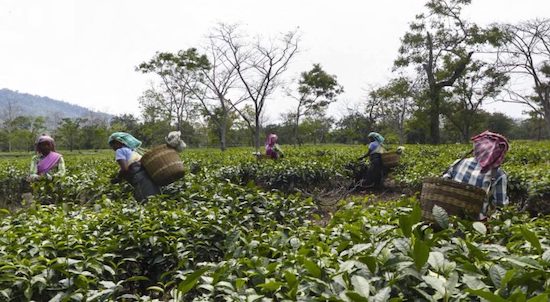
The Accountability Console has a page dedicated to each of the 1,395 complaints filed to accountability mechanisms. Complaint pages do more than display the data of a specific complaint; they tell the stories of communities facing harm, and their attempts to find remedy. Here is one example.
In February 2013, three local civil society organizations filed a complaint to the International Finance Corporation’s Compliance Advisor/Ombudsman (CAO) to raise concerns about inhumane labor and working conditions on three tea plantations run by Amalgamated Plantations Private Limited (APPL). The complaint cites long working hours, inadequate compensation, poor hygiene and health conditions, coercion and pressure of plantation workers, and lack of freedom of association.
This complaint, and all others filed to accountability mechanisms, are included in the Accountability Console database, where they are parsed, categorized, tagged, and stored in their component pieces. Though this process helps us analyze and compare complaint data in the aggregate, it is easy to lose sight of where this data originates: in the communities, the harms they faced, and the steps they took to find remedy. This is an attempt to recreate the story of a complaint using Accountability Counsel’s Assam case as an example.
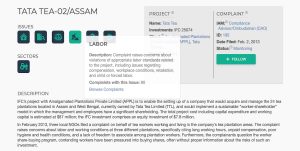
Below the name of the complaint are icons representing the issues raised by the complainants, and the sectors of the corresponding project. Hovering over any of the icons provides a definition of the issue or sector, as well as a link to see all complaints with the same issue/sector. For standardization and comparability, the issues are categorized: “Community health and safety”, “Due diligence”, “Human rights”, “Labor”, and “Retaliation.” Since other issues, like concerns about the workers’ freedom of association, don’t fit into any of our categories the “Other” icon is also present. The sector relevant to this complaint about tea plantations is “Agribusiness.”
To the right of the Issues and Sectors is a gray information box with information on both the project and the complaint. The project side on the left contains the following items:
- Name: The name of the project. When available this links to a “project” page on the Console that contains information on all complaints filed regarding any investments in that project. In this case, we can see that an additional request for investigation was initiated by the CAO Vice President, based on submitted by the International Union of Food Workers (IUF) to the IFC.
- Investments: The specific bank investments about which the complaint was filed. When available, these will hyperlink to the bank’s own page about the investment. This link takes us to the IFC’s disclosures page about their Tata Tea equity investment.
- Client: The implementers or recipients of financing from the project. When available, each client links to a “client” page on the Console that contains information on all complaints filed related to that client. Clicking on “Tata Group” here allows us to see that two other complaints have also been filed involving the Tata Group, related to a coal power plant in Gujarat.
- Support: The type of support provided by the investments listed above, which may be a loan, a grant, equity, advisory services, or a risk guarantee. Clicking “Equity” here links to a list of all complaints about equity investments.
- Country: The country in which the project was implemented. Clicking the country name will take you to a list of all complaints in the country, in this case India, which has the highest number of complaints of any country.
The complaint side on the right contains the following items:
- IAM: The name of the accountability mechanism to which the complaint was filed. Clicking the name leads to a page on the mechanism itself, along with a list of all complaints handled by that mechanism.
- ID: The unique identifier used by the mechanism to track the complaint. When available, the ID will hyperlink to the IAM’s own page about the complaint.
- Date Filed: The date the complaint was received by the IAM.
- Status: The current state of the complaint, which can be Active, Monitoring, Closed with Outputs, Closed without Outputs, or Closed with Outputs Outside Process.
- Follow: For registered users, clicking the “Follow” button will enable you to receive email updates whenever new information about this complaint is added to the Console.
Next is the complaint description, which is taken directly from the IAM’s complaint registry when available, and often describes the nature of the complaint and harm raised. In this case, the CAO’s description provides both the background of the complaint, along with the steps taken by the CAO to resolve it.
The graphical representation of the complaint stages shows all possible stages of a typical IAM process; stages that have been or are currently being undertaken are shaded blue, while stages that have not are shaded gray. Here we can see that the Tata Tea complaint was filed on Feb 2, 2013, with an eligibility assessment taking place soon after. The registration stage is grayed out because the CAO has no separate registration process. By hovering over the Dispute Resolution stage, we can see that the mechanism determined that a dialogue could not take place in this process. We can explore the particulars of this decision by checking the CAO registry page, or the documents section below. They reveal that despite workers’ repeated requests to initiate a dispute resolution process, no progress was made on addressing retaliation against workers on the plantations or reaching an agreement on the role of supporting organizations in a dialogue process.
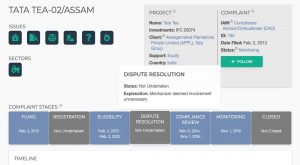
When hovering over the Compliance Review stage, we can see that a formal investigation found non-compliance with the IFC’s social and environmental safeguard policies. These findings can be explored in the Documents section below. The compliance report found that the IFC’s pre-investment review of the risks was insufficient given the vulnerable status of workers. The findings of this investigation are grave; non-compliance was found in relation to the IFC’s supervision of living and working conditions on the plantations, reported use of banned pesticides, information disclosure, consultation, and response to security incidents. The IFC’s response to these findings can also be found in the Documents table, as are several CAO compliance updates which note that the IFC has not delivered on specific commitments included in its response. All these documents are also included in our DocumentSearch feature, where their text has been scanned and indexed to be searchable.
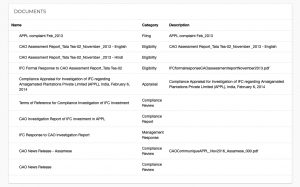
When information is available on groups involved in the filing or support of a complaint, they are listed below the document list. Clicking a group will take you to a list of all complaints with which the group is publicly affiliated. If you know of additional groups that should be associated with any complaint, please don’t hesitate to contact us, using our Contact Form. If other complaints have been filed about the same project, they will be listed in a “Related Complaints” table.
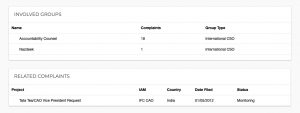
We hope you will explore some of the other stories contained in the Console. As with all other pages and information, we welcome your feedback and suggestions on future improvements on how to tell these stories better; just click the red exclamation point in the bottom right corner to send us questions, suggestions, or to alert us when something isn’t working as designed. We would also love to hear how you use the Console, what insights you’re uncovering, and how we can relate these stories better.
This article was originally published in the Accountability Console Newsletter, where AC’s Research team shares research and insights from the world’s most comprehensive database of Independent Accountability Mechanism (IAM) complaints, the Accountability Console. Click here if you would like to subscribe to the monthly Console Newsletter.

